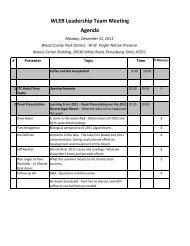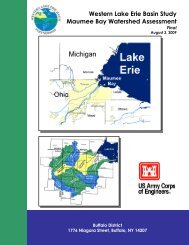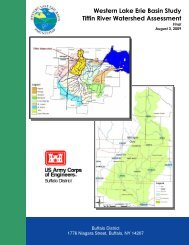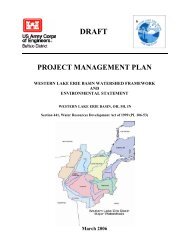Tom Bridgeman – Maumee Bay Lake Erie Algal Blooms
Tom Bridgeman – Maumee Bay Lake Erie Algal Blooms
Tom Bridgeman – Maumee Bay Lake Erie Algal Blooms
You also want an ePaper? Increase the reach of your titles
YUMPU automatically turns print PDFs into web optimized ePapers that Google loves.
Harmful <strong>Algal</strong> <strong>Blooms</strong><br />
in <strong>Lake</strong> <strong>Erie</strong><br />
Thomas B. <strong>Bridgeman</strong><br />
U. Toledo Tl <strong>Lake</strong> Lk <strong>Erie</strong> Ei Center
Three Major HAB species in <strong>Lake</strong> <strong>Erie</strong><br />
Microcystis aeruginosa<br />
Cladophora spp.<br />
Lyngbya y<br />
wollei / Plectonema wollei
Major groups in <strong>Lake</strong> <strong>Erie</strong><br />
Bacillariophyta<br />
(Diatoms)<br />
Chlorophyta<br />
(Green)<br />
[Cladophora]<br />
Cyanobacteria<br />
(Blue-green)<br />
[Microcystis, Lyngbya]
Blue-green<br />
Algae in <strong>Lake</strong> <strong>Erie</strong><br />
Anabaena<br />
Aphanizomenon<br />
Microcystis
Microcystis bloom<br />
August 2003<br />
Toledo Water Intake
Why should we care?<br />
Microcystis may produce a toxin<br />
(Microcystin)<br />
If ingested, toxin damages the liver<br />
•Brazil 1988, 1996: 88 deaths when reservoir developed<br />
Microcystis bloom, 55 dialysis patients poisoned (1996)<br />
•many animal poisonings<br />
Skin contact t may cause allergic rash
•Economic Costs<br />
•City of Toledo spends an extra $10,000 per day<br />
to treat drinking water during Microcystis<br />
blooms.<br />
•Recreational fishing and boating affected.<br />
•Rotten smell, fouled beaches may cause visitors<br />
to go elsewhere for recreation.
Research Goals<br />
•Monitor and quantify annual<br />
Microcystis blooms<br />
•Examine environmental<br />
influences that may explain<br />
variation in Microcystis blooms<br />
between years.
•Monitor and quantify<br />
annual Microcystis<br />
blooms<br />
Quantify Microcystis in archived plankton<br />
tows from 2002-present (~400 samples)
25000<br />
20000<br />
15000<br />
10000<br />
5000<br />
2002 2003 2004 2005 2006 2007<br />
0<br />
To<br />
otal Microcy<br />
ystis vo<br />
olume<br />
Micro<br />
cystis (ml<br />
m yr )<br />
(ml / m<br />
2 )
<strong>Maumee</strong> River summer discharge<br />
18000<br />
Mean M aumee Rive er Discharg ge (ft 3 s -1 )<br />
16000<br />
14000<br />
12000<br />
10000<br />
8000<br />
6000<br />
4000<br />
2000<br />
0<br />
June<br />
July<br />
August<br />
1930-2005 2002 2003 2004 2005 2006<br />
(m 3 x 10 5 )
Microcystis <strong>Blooms</strong> vs Summer River Discharge<br />
(ml / m<br />
2 )<br />
-1<br />
stis (ml m -2 yr )<br />
Microcys<br />
volume<br />
ocystis<br />
tal Micro<br />
Tot<br />
25000<br />
20000<br />
r 2 = 0.9195 2003<br />
15000 2004<br />
10000<br />
5000<br />
2007<br />
2005<br />
2002<br />
2006<br />
0<br />
0.0 0.5 1.0 1.5 2.0<br />
Jun. 1 - Aug. 15 Total discharge (m 3 x 10 9 )
Microcystis <strong>Blooms</strong> vs Winter-Spring<br />
River Discharge<br />
25000<br />
r 2 = 0.1185<br />
2003<br />
20000<br />
tis (ml m -2 yr<br />
-1 )<br />
15000<br />
2004<br />
Microcyst<br />
10000<br />
5000<br />
2006<br />
2005<br />
2007<br />
2002<br />
0<br />
1.0 1.5 2.0 2.5 3.0 3.5<br />
Jan. 1 - April 30 Total discharge (m 3 x 10 9 )
(S.J. Ross)<br />
Cladophora<br />
• Grows best in<br />
•Clear water<br />
•Rocky substrate<br />
• Non-toxic<br />
• A “bathtub ring” species<br />
•Mainly a problem in<br />
eastern <strong>Lake</strong> <strong>Erie</strong><br />
(E. Young)<br />
(Wisconsin DNR)
Lyngbya y<br />
Wollei<br />
• Nuisance blooms most often reported in northern Florida and<br />
Georgia springs beginning in the 1970s, coinciding with<br />
increasing agriculture and nutrient enrichment of groundwater<br />
• Mats are benthic<br />
for most of year<br />
but become buoyant<br />
due to trapped<br />
oxygen bubbles.<br />
• Strains of Lyngbya<br />
wollei in southeast US<br />
are known to produce<br />
potent neurotoxins<br />
• Toxin production has<br />
not been found in<br />
<strong>Lake</strong> <strong>Erie</strong> Lyngbya<br />
A. Pinowska<br />
• Tough polysaccharide sheath allows filaments to<br />
persist year-round, requires Calcium
September-October<br />
Benthic mats become buoyant and float to surface<br />
(<strong>Maumee</strong> <strong>Bay</strong> State Park)<br />
T. Fisher
September 2006<br />
• In protected area in front of the U. Toledo <strong>Lake</strong> <strong>Erie</strong><br />
Center, approximately 200 tonnes (wet weight) of Lyngbya<br />
covered a 100m stretch of shoreline.
Floating Lyngbya mats 5 miles offshore
Lyngbya<br />
Lyngbya survey, summer 2008<br />
(Yellow = shoreline, blue = lake bottom)
Lyngbya<br />
Lyngbya beds at MBSP
Why Lyngbya y rather than Cladophora?<br />
• Lyngbya does not have a means of<br />
attaching to hard substrate (unlike<br />
Cladophora), but can adhere to softer<br />
substrates such as sand and crushed<br />
zebra mussel shells<br />
• Lyngbya grows well under low light<br />
conditions (unlike Cladophora)<br />
Cladophora<br />
Lyngbya<br />
Long filaments X X<br />
Benthic X X<br />
Light<br />
preference<br />
Bottom type<br />
High<br />
Rocky, ZM<br />
Low<br />
Sandy, ZM frag








